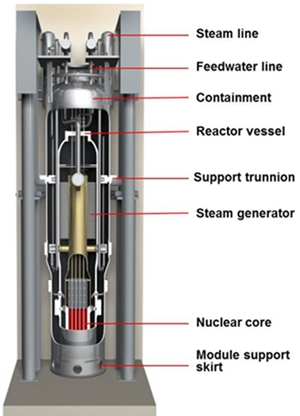NuScale Power is about to bring a new nuclear reactor to the commercial power
market. In September 2018, the nuclear
power technology developer announced the selection of BWX Technologies, Inc. as
the manufacturer of NuScale’s innovative Small Modular Reactor (SMR). The announcement was first of its kind in the
nuclear power industry that is accustomed to construction in place for nuclear
reactors. NuScale’s factory-built reactor
could bring sweeping change to the nuclear power industry.

Making this
possible is a different approach to nuclear reactor design. Starting with research and development work
completed at Oregon State University, NuScale designed a small-scale nuclear
reactor module that can be operated alone or in a group of as many as twelve
modules. Each module is capable of
generating 50 megawatts of electricity.
There are
several design innovations in the modules that are aimed at improving safety
and increasing efficiency.
·
The small core design uses only 5%
of the nuclear fuel of the typical large-scale reactor. The smaller scale means more stability and
reduces fuel damage in the case of unforeseen accidents.
·
High-strength steel containment
vessel houses the reactor core, pressurizer and steam generator in a cooling
pool. This serves as a heat exchanger
and eliminates the spray cooling systems, reactor vessel insulation and other
heat-handling equipment.
·
No electrical power supply is
needed for safe shutdown and cooling in the event of an accident. Instead,
Battery arrays are available.
·
Power generators in particular
might like the helical coil steam generators that deliver improved thermal
efficiency without the usual reactor coolant pumps.
The streamlined
design can be built in a central location.
Not only is the nuclear power module built in a factory, large parts of
the final power plant can be manufactured in an efficient factory setting and
then assembled at the plant location.
For example, the chemical control processes can be manufactured as a
modular system, mounted on a skid and then shipped to the plant site.
NuScale is not
the first nuclear reactor developer to consider modular construction in a
central location. Westinghouse Electric
attempted to apply modular construction techniques to projects calling for its
AP1000 reactor. Projects to build
large-scale plants in the U.S. for Southern Company and SCANA were fraught with
a multitude of problems, including design issues, construction errors that
resulted in delays and cost overruns.
However, Westinghouse has been successful in China. A plant in Zhejiang
province featuring the AP1000 in its third generation began the fueling stage
in April 2018, after Westinghouse adjusted the design and solved supply chain
problems. The Westinghouse AP1000 is a
much larger reactor and is only 50% modular.
The NuScale reactor size is significantly smaller and thus may prove
must easier to transfer from factory to installation.
The prospect of
lower capital costs, shorter assembly time and more efficient operations must
have power generators salivating over NuScale’s SMR. Utah Associated Municipal Power Systems
(UAMPS) has already teamed up with the Idaho National Laboratory for a
twelve-module deployment at the laboratory site. The project awaits approval of NuScale’s
design by the U.S. Nuclear Regulatory Commission (NRC). NuScale’s application was submitted in late
2016, and is expected to receive certification by the beginning of 2021. UAMPS thinks its planned power plant could
become operational sometime in 2026.
An economic
study completed in 2014 by the UK National Nuclear Laboratory, determined that
worldwide there is demand for at least 20 gigawatts of power from small modular
reactors by the year 2025, with demand rising to 70 gigawatts by 2035. The greatest interest is likely from the U.S.,
where demand is expected to reach 7.5 GW by 2025. The forecast suggests NuScale could be
arriving at the U.S. market with an approved design at just the right time.
Does NuScale Power have sufficient financial strength
to move into commercial stage? The next
post in this two-part series looks at NuScale’s capitalization and financing
power.
Neither the author of the Small Cap Strategist web log,
Crystal Equity Research nor its affiliates have a beneficial interest in the
companies mentioned herein.
No comments:
Post a Comment